- Home
- Nicholas Sparks
Three Weeks With My Brother Page 22
Three Weeks With My Brother Read online
Page 22
Micah had worked a couple of summers loading trucks for Consolidated Freightways and knew how to load the items to prevent them from being damaged. With the exception of the driver’s seat, the car was completely filled. We were standing just inside the door when the time came to say good-bye; I’d already said my good-byes to Dana and my dad. But it was time to go, and both Micah and I knew it.
In the house were a thousand memories; in my mind, I could hear mom’s laughter from the kitchen, and see my brother and sister at the table. For the second time in my life, I was leaving my family, but this time was different. The last time I’d left, I’d been a teenager; now I had a family of my own; I knew I’d never be moving back.
“It looks like when we loaded the Volkswagen to move here, doesn’t it?” I cracked.
“It’s pretty full. But at least it’s level this time. How long will it take you to get there?”
“Four days or so.”
“Drive safe.”
“I will.”
We hugged. “I’m going to miss you,” I said.
“I’ll miss you, too.”
“I love you, Micah.”
He squeezed harder. “I love you, too, little brother.”
When we separated, I could feel the tears coming, but tried to hold them back. We’d come to depend heavily on each other in the last three years, but I tried to diminish the significance of what was happening. I told myself that we were simply moving; it wasn’t as if we wouldn’t see each other again. I’d come to visit him and he’d come to see me. We’d talk on the phone.
“You’re wearing my shorts,” I said randomly.
“I’ll give them to you tomorrow,” he said without thinking. “No,” he added quickly. “I won’t. You’ll be gone tomorrow. I can’t give them to you.”
At that, Micah began to cry and he leaned into me again.
“It’s okay, Micah,” I whispered, beginning to cry as well. “It’s going to be all right.”
And a few minutes later, through my own blurry tears, I saw his image in the rearview mirror grow smaller. He was standing on the lawn, forcing a smile and slowly waving good-bye.
CHAPTER 14
Jaipur and Agra, India
February 7–8
We landed in Jaipur, a city of two and a half million people in northern India, and the capital of the state of Rajasthan. Famous for its forts, palaces, and colorful culture, Jaipur is frequently called “The Pink City,” and is the commercial center for most of the rural regions of Rajasthan.
Though we weren’t sure what to expect, we quickly learned that India was a country like no other. After showing our passport in three different places, we boarded the bus that would take us through the city of Jaipur to the Amber Fort, which was once home to the Maharaja.
Our guide spoke perfect Indian-accented English, and as we made our way across the city of Jaipur, he informed us that Jaipur is regarded as one of India’s most beautiful cities. He seemed to believe it as well. In the forty minutes it took to reach our destination, he would point out various monuments and explain what they were. His favorite words, as far as we could tell, were Jaipur, beautiful, and pink. Every description contained or ended with a variation of the following:
“Jaipur. The beautiful city. Jaipur. The pink city. Look. Can you see how beautiful it is? The landscape is beautiful, and the buildings in the old town are painted pink. Jaipur is the pink city. Jaipur is the beautiful city.”
Meanwhile, Micah and I were staring out the windows with our mouths agape.
People were everywhere. The sidewalks and streets were packed, and our bus shared the roads with pedestrians, scooters, bicycles, camels, elephants, donkeys, and horse-drawn carts, all moving at different speeds and zigzagging in traffic. Cows—sacred in the Hindu culture—roamed freely throughout the city, nosing through piles of garbage along with dogs and goats.
The poverty struck us forcefully. Ragged tent sites and houses slapped together with rotting boards or whatever discarded materials could be found were home to tens of thousands of people. They lined the main thoroughfare and all the crossroads we passed. People dressed in rags were everywhere, and dozens, if not hundreds, were sleeping in the gutter. People defecated and urinated in plain view, yet no one but us seemed even to notice. The smell of diesel fuel was overwhelming.
Meanwhile, our guide continued.
“Look at the fancy houses just beyond the walls. Can you see how beautiful they are? In the old town, all the buildings are pink. Jaipur is the pink city. Jaipur is the beautiful city.”
Micah leaned over to me. “Where are the fancy houses again?”
“I think he said they’re behind the walls over there. See those roofs?”
“You mean behind the slums?”
“Yeah.”
“And this is a beautiful city? He’s got to be out of his mind.”
At that point, one of the other members of our tour who was sitting behind us leaned forward.
“Actually,” he said, “Jaipur is wealthy when compared to some of the other cities in India. You can’t even begin to imagine what Calcutta or Bombay look like.”
“It’s worse than this?” Micah asked.
“By a long shot. Believe it or not, Jaipur is the beautiful city.”
After that, all we could do was stare out the windows, wondering how on earth people survived like this.
The Amber Fort, located six miles from the city, was built atop a hill, and is surrounded by peaks and easily defended valleys that made it ideal for protection of the Maharaja.
At the base of the fort, we broke into groups of four and rode elephants up the long, winding road that led to a large courtyard that served as the entrance to the fort itself.
It took some time for our entire group to arrive at the gates—we’d needed over twenty elephants, and they moved slowly. Micah and I quickly learned that Indian vendors were even more aggressive than those in Peru. They crowded around us in groups of four to six, all of them holding trinkets, undercutting each other’s prices. It didn’t matter if we said no or walked away; they simply followed us, each of them almost shouting to get our attention. If we refused a second time, they closed in tighter and spoke even louder. The people in the tour first to arrive at the fort clustered in a defensive circle, backs to the crowd, trying hard to ignore the shouts. The vendors kept at it for over thirty minutes. In the end, they would follow our group right up to the door.
We toured the Amber Fort for the next hour, marveling at the blend of Hindu and Muslim architecture. There were spacious, scenic courtyards, high-quality paintings and frescoes, and individual apartments for the dozen concubines of the Maharaja. We took photographs in front of a large garden that used an ingenious system of irrigation to enable the flowers to bloom year-round, and eventually made our way to the upper levels, where we could appreciate the fort’s location from a defensive standpoint.
Yet it was the Hall of Mirrors that was most impressive. It was our first exposure to the intricate marble work for which the fort had become famous, and up close the workmanship was of higher quality than anything we’d seen. Built over ten years and using two thousand workers, the Hall of Mirrors has marble walls, inlaid with tens of thousands of precious and semiprecious stones, as well as thousands of tiny mirrors. In the evening, we were told that the Maharaja would be entertained by candlelight in front of the hall, where the stones and mirrors would reflect the gentle light. While the relief carvings of Angkor Wat had been detailed, even I understood that it was far more difficult to work with marble. Every one of the tens of thousands of inlaid gems and mirrors fit perfectly.
“It’s incredible,” Micah whispered. “But I think it’s almost too much. A little gaudy for my tastes.”
“Well, that’s all right. I don’t think you can find anyone who even knows how to do work like this anymore. Unless you move to India, of course.”
“I don’t think that’s going to happen.”
After leavi
ng the fort, we drove through one slum after the next, passed through a gate, and—in a way that only India can truly surprise—found ourselves in paradise.
Our hotel was once a palace owned by the Maharaja. The rooms were laid out in cabana style, and the grounds were impeccable. Lush with trees, fountains, winding paths, and flowers, there was also a full-service health spa, tennis courts, fitness center, and swimming pool. The employees were both professional and efficient; if we so much as glanced in their direction, they rushed toward us to see if there was anything they could do. Every member of the tour was escorted to his or her rooms by individuals who not only explained the features of the rooms in exceptional detail, but offered to pick up laundry and shine shoes as well, with the promise that everything would be returned within a couple of hours. It was the most luxurious hotel we would stay in on the tour, yet no matter how nice it was, neither Micah nor I could escape the reality that we knew lay just outside the door.
In the evening, we attended yet another cocktail party and had our heads wrapped in turbans for our visit to the City Palace. There, we were greeted in typically royal fashion; contingents of guards stood at attention alongside camels, white stallions, and elephants, all of which had been decorated for our arrival. We had dinner and were treated to a show with traditional Indian entertainers, but both Micah and I were tired from the day and looked forward to nothing more than getting back to our room and crashing.
In the morning, we had two choices: We could visit the museum and various shopping areas, or simply stay at the hotel.
Micah and I stayed at the hotel. Neither one of us had any desire to leave the sanctuary of our compound, and for the first time in two weeks, we did absolutely nothing at all. In the afternoon, Micah was wearing sunglasses and a bathing suit, relaxing in a lounge chair near the pool.
“Now this,” Micah said, “is exactly what I needed.”
“I know what you mean,” I said. “I feel sort of guilty, though. It could be my last chance to see India, and we’re sitting by the pool at the hotel.”
“Did you really want to see another museum and go shopping?”
“No. I’m just saying that it makes me feel guilty.”
“You always feel guilty. That’s your problem.”
“I thought my problem was that I didn’t have enough friends.”
“That, too.”
I opened my arms wide in mock gratitude. “That’s why I like you, Micah. You’re always willing to offer constructive criticism.”
“I’m glad to help. Besides, someone had to take over after mom died.”
“She was irreplaceable.”
“You know what she was?” Micah reflected. “She was like the center of the wheel in our family, and we were all the spokes. And once she was gone, we didn’t have our center anymore. I think that’s why the loss hit us so hard. Not only was mom gone, but we had to become a new kind of family. I think that’s why you, me, and Dana started to get close again.”
“What about dad?”
“I don’t know,” he said. “Part of it was losing mom, but I still think dad was manic-depressive. When mom was around, I think she was able to keep his mood swings under control. But after she was gone—well, dad didn’t have a center either.”
“Do you think he was a good dad? When we were growing up, I mean?”
“In some ways. Not so good in others. But you know, in the end, you have to give them both credit for being good parents simply because of the way their kids turned out. We’re happily married, successful, ethical, and we remained close as siblings. If your kids can say the same thing later in life, won’t you think you did a good job as a parent?”
“Without a doubt,” I conceded.
In the morning, we flew to Agra, where we’d visit the Taj Mahal.
Agra held the same sights outside our bus windows as had Jaipur, with two major differences: There was far more pollution in the air, and far more roads were unpaved.
Because of the pollution, we had to change buses; to reach the Taj, we’d ride the last couple of miles in electric buses, and ended up stopping a quarter-mile from the gates.
From where we parked, it was impossible to see the Taj Mahal. What most people don’t realize is that the Taj is actually part of a massive compound. Again, we waited in a long line—this one to check our bags for explosives or weapons—and we finally entered the compound. Even then, we couldn’t see the monument.
Instead, we filed along a sidewalk, flanked on either side by what had essentially been apartments for guests of Shah Jahan. Up ahead and to the right was a large brick structure that served as a massive ornamental gate, and again we had to wait in line and be checked before passing through.
On the other side, however, we finally had our first glimpse of what some regard as the finest monument to love ever constructed.
The Taj Mahal was begun in 1631 by Shah Jahan, a Mughal emperor, in memory of his second wife, Mumtaz Mahal, who died after giving birth to their fourteenth child. It is, in other words, a tomb. The cenotaph honoring Mumtaz Mahal inside the Taj is inlaid with jewels and lies near that of her husband’s. The Taj is one of the most symmetrical buildings ever constructed—the cenotaph of Mumtaz is directly in the center of the dome; the four corner towers are exactly the same distance from the dome; and exactly the same height.
The Taj took twenty thousand workers, one thousand elephants, and twenty-two years to build, and material was brought in from all over India and Central Asia. It is regarded as a symbol of eternal love, yet Shah Jahan spent little time there. Soon after it was completed, Shah Jahan’s —and Mumtaz’s—son deposed the emperor and imprisoned him in the Great Red Fort, a few miles away. While Shah Jahan could see the Taj from his prison cell, he was never allowed to set foot in the Taj Mahal again.
From where we stood, it didn’t look real; set against a murky, polluted sky, the marble shone brilliantly, and the image was reflected in the long, rectangular ponds before it. Most people, when seeing pictures of the Taj Mahal (which means “Crown Palace”), believe it’s constructed of white, unadorned marble; only up close does the detail of each marble block become vivid. Like the Hall of Mirrors—only on a much larger and grander scale—the Taj Mahal is adorned with precious and semiprecious stones, inlaid in the shapes of flowers and vines. After taking pictures, we made the walk to the monument itself and studied the ornamental facade.
“Now that’s a lot of marble,” Micah offered succinctly.
We spent a little more than an hour at the Taj Mahal, which surprisingly sufficed. The Taj, after all, is a crypt; there is not much inside other than the small room where Mumtaz and eventually Shah Jahan were buried, and most attention is directed to the detail of the marble blocks used in the construction. And it is amazing; yet, because the Taj had been built with such mathematical precision, the artistry seemed curiously uninspiring. If you found a design on one side, the exact same design was mechanically replicated on the opposite side. While a marvel of construction, it was strangely repetitious.
Both Micah and I were fascinated by the fact that the son had imprisoned the father and never let him set foot in the Taj Mahal—the crypt of his own mother—during the last years of Shah Jahan’s life.
“You see,” Micah said, with a knowing nod. “That’s exactly what I was talking about. Dad was a lot better father than old Shah Jahan must have been. His kid hated him.”
I nodded in agreement. And yet, as I stared up at the massive monument to Mumtaz, I found myself thinking not about my father, but about my sister.
In January 1993, less than three weeks after I moved to North Carolina, I was back in California.
Right after the new year, my sister had gone to see a new physician; he had ordered a new MRI from a different hospital. MRI scanning machines, at that time, were undergoing rapid technological change, and the newer machines were able to provide images that their predecessors were not. Dana’s image, we were told, had been taken on a dated machine; a
new image might provide the answers.
She lay on the bed, put earplugs in, and was rolled into the machine. The machine makes loud clanking noises—like someone banging a pan with a spoon—and within a few hours the scans were ready. And there, plain as day, was something that wasn’t supposed to be there. Dana, we learned, had a brain tumor.
She was scheduled for immediate surgery at UC San Francisco, and I flew out to join Micah and my dad. In the hotel the night before, Micah and I tried to keep the mood upbeat, but my dad was extremely tense throughout the evening. It was only when Micah and I were alone that we felt comfortable enough to talk about our own fears and worries.
Our sister, our younger sister, had a brain tumor. As if losing our mother hadn’t been hard enough, we now had to confront this.
The surgery was scheduled for early in the morning and we brought Dana to the hospital a little before seven. Because of tight schedules, however, the surgery didn’t begin until nearly noon, making the day one of the longest in our lives. It wasn’t until after 7:00 P.M. that the doctor came to talk to us.
He told us the surgery had gone well and that they’d removed as much of the tumor as they could. It hadn’t been possible to remove it all. Parts of the tumor had spread to areas deep within her brain and other parts were intertwined with areas of the brain that performed vital functions. To have removed every speck of the tumor, the doctor informed us, would have left Dana in a vegetative state.
It took a long time for the doctor to explain Dana’s condition to us in a way that we’d eventually understand. We wanted specifics—how much of the tumor is left, where is it located, what does it mean in the long run—but brain surgery, we would come to learn, is often more about judgment than rules.
“When she recovers,” the doctor said, “she’ll start her antiseizure medication and begin radiation. Hopefully, that will kill whatever was left of the tumor, the parts we couldn’t get to.”

 The Notebook
The Notebook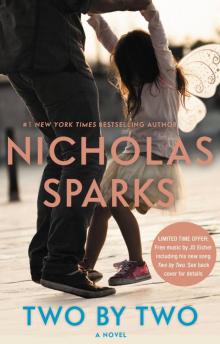 Two by Two
Two by Two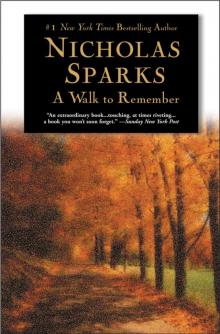 A Walk to Remember
A Walk to Remember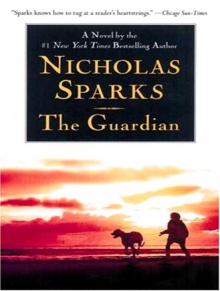 The Guardian
The Guardian Dear John
Dear John The Last Song
The Last Song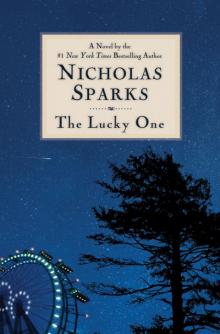 The Lucky One
The Lucky One The Wedding
The Wedding The Longest Ride
The Longest Ride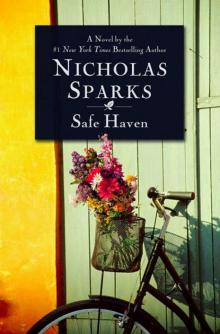 Safe Haven
Safe Haven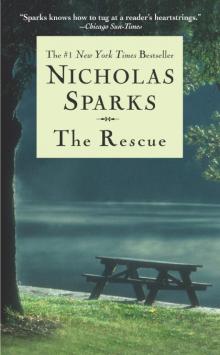 The Rescue
The Rescue The Wish
The Wish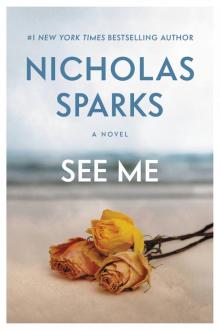 See Me
See Me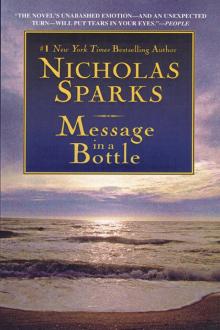 Message in a Bottle
Message in a Bottle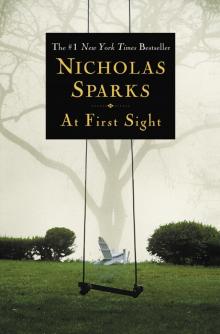 At First Sight
At First Sight True Believer
True Believer The Return
The Return A Bend in the Road
A Bend in the Road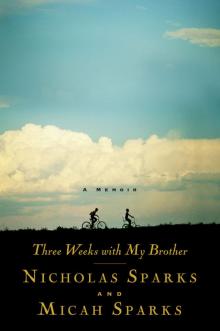 Three Weeks With My Brother
Three Weeks With My Brother Nights in Rodanthe
Nights in Rodanthe Every Breath
Every Breath